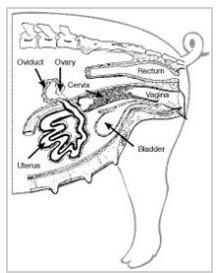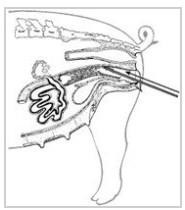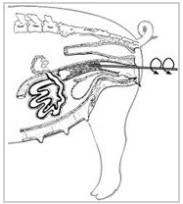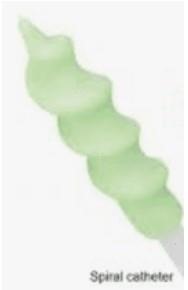Pig reproduction is an adventure for new swine enthusiasts. The thought of farrowing a litter of piglets from the champion gilt is overshadowed by how to get her bred. This article is an overview of the anatomy and description of the estrous cycle of swine and artificial insemination (AI).
Swine Estrous Cycle
Domesticated swine are classified as nonseasonal and polyestrous (cycles year around). There are four phases to the estrous cycle (proestrus, estrus, metestrus, and diestrus). On average, the estrous cycle takes 21 days but ranges from 17 to 25 days. The first day of estrus or standing heat, when the female is receptive to the male, is day 0 and lasts for 2 to 3 days. The ultimate sign of estrus is the female taking the breeding stance (lordosis) in the presence of a boar or a positive response to the “back-pressure” test (hand pressure applied to the back, grasping the flank, followed by gently sitting on the females back to elicit the standing response). Other signs of estrus include mounting or standing to be mounted by other females, erect ears, and increased vocalization. Ovulation (release of the egg from the follicle on the ovary) occurs 23 to 48 hours after the onset of estrus. For this reason, the recommendation is a minimum of two inseminations.
Detecting Estrus
The importance of estrous detection in an AI system cannot be overemphasized. The producer must be able to accurately determine the onset of estrus. Twice-daily estrous detection is more effective, when done properly and at 12-hour intervals, than once-daily detection. If a boar is used, estrous detection should be conducted in a neutral pen in groups of 12 or less. Estrous detection without a boar should be done when females are not distracted or frustrated (feeding time). For sows in gestation stalls or pens and no boar, each sow should be “courted” nudging or grasping the flank and applying back pressure. When back pressure is applied to the female a standing reflex should occur if the female is in estrus/heat.
Females should be mated 2 to 3 hours before ovulation. Factors affecting ovulation are farms, genetics, and individual females. Likewise, gilts ovulate sooner after onset of estrus than sows. To provide consistency, it is recommended all females be mated each day she stands. While this potentially results in some waste of semen, it is the best way to ensure at least one mating is optimally timed relative to ovulation.
The Female Reproductive System
The reproductive system of swine is more conducive to AI than cattle or sheep. Still, a proper understanding of the system is important for best results. Figure 1 shows the reproductive organs of the female. The vulva is the visible portion of the female reproductive tract. The vulva leads to the vagina/birth canal, which tapers into the cervix. The cervix consists of multiple ridges which act as a barrier to prevent entrance of foreign material into the uterus. During estrus, the cervix dilates, and in natural mating, the boar’s penis (which is corkscrew-shaped) penetrates the folds of the cervix, and the pressure initiates ejaculation and uterine contractions.
These contractions transport the ejaculate to the oviduct, the site of fertilization. Remember: ovulation occurs 23 to 48 hours after the onset of estrus and takes 1 to 4 hours to complete, the ovary releases eggs (15 to 24) which enter the oviduct, and then travel to the site of fertilization. Freshly ejaculated or extended semen must be in the oviduct 2 to 3 hours before the eggs arrive to undergo sperm capacitation a biological change required for fertilization.

Figure 1. Reproductive anatomy of the sow. Source: After E.S.E. Hafez, editor, 1974. Reproduction in Farm Animals. Philadelphia: Lea and Febiger

Figure 2. Insert the spirette at an upward angle to avoid the urethra.

Figure 3. Use a counterclockwise rotation to insert the spirette into the cervix.
Inseminating the Female
- Semen quality is affected by handling, dilution, shipment, storage, fluctuations in temperature, and time post collection which affect shelf life, motility, and viability of the sperm.
- Start by lubricating the tip of the spiral catheter or spirette (figure 4) using a few drops of extender.
- Now gently guide the spirette without semen bottle attached and the tip pointed up (avoid the urethra) through the vulva then to the vagina followed by the cervix (Figure 2).

Figure 4. AI spiral (spirette) catheter
The spirette is gently pushed forward while turning counterclockwise to introduce the spirette into the cervix (Figure 3) continue until resistance is felt. Check placement by gently pulling back on the spirette.
Once in place, gently invert the bottle of semen three times to mix the semen then attach to the spirette. To initiate semen flow, turn the spirette tube/bottle up to a 90o angle gently squeeze the bottle then allow gravity and uterine contractions to take in semen . Semen delivery should take a minimum of three minutes. Providing proper stimuli during AI such as, back pressure, massaging the females flank and clitoris will increase contractions to transport semen to the uterus and oviduct. Rushing semen delivery causes backflow out of the vulva (wasted). Remember you are replacing the boar, who spends five to ten minutes breeding a female.
- If excessive backflow occurs, stop. Semen is being delivered too fast or the spirette is not locked into the cervix. If semen flow stops, turn spirette a quarter turn (reposition) to restart semen flow.
- To maintain semen flow, vent the semen bottle using side cutters to reduce a vacuum buildup and allow the semen bottle to empty.
- Semen transport, and fertilization, is more effective when females remain calm. The standing reflex with accompanying uterine contractions is vital to sperm transport during AI.
- Once semen is deposited, remove the spirette by rotating clockwise while gently pulling.
- Keep the female in quiet surroundings for 20 to 30 minutes. Distress at this time may still disrupt semen transport and fertilization.
Source : aces.edu